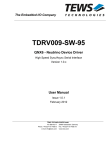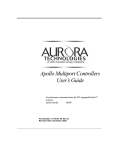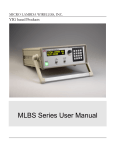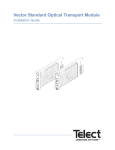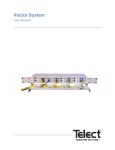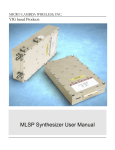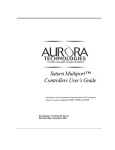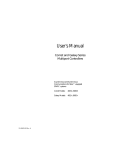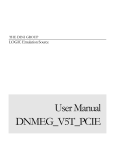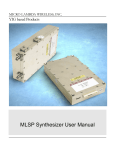Download TDRV009-SW-65 - TEWS Support Website in Taiwan
Transcript
The Embedded I/O Company TDRV009-SW-65 Windows 2000/XP Device Driver High Speed Sync/Async Serial Interface Version 1.0.x User Manual Issue 1.0.2 June 2008 TEWS TECHNOLOGIES GmbH Am Bahnhof 7 Phone: +49 (0) 4101 4058 0 25469 Halstenbek, Germany Fax: +49 (0) 4101 4058 19 www.tews.com e-mail: [email protected] TEWS TECHNOLOGIES LLC 9190 Double Diamond Parkway, Suite 127, Reno, NV 89521, USA www.tews.com Phone: +1 (775) 850 5830 Fax: +1 (775) 201 0347 e-mail: [email protected] TDRV009-SW-65 This document contains information, which is proprietary to TEWS TECHNOLOGIES GmbH. Any reproduction without written permission is forbidden. Windows 2000/XP Device Driver High Speed Sync/Async Serial Interface TEWS TECHNOLOGIES GmbH has made any effort to ensure that this manual is accurate and complete. However TEWS TECHNOLOGIES GmbH reserves the right to change the product described in this document at any time without notice. Supported Modules: TPMC863 TPMC363 TCP863 TEWS TECHNOLOGIES GmbH is not liable for any damage arising out of the application or use of the device described herein. 2007-2008 by TEWS TECHNOLOGIES GmbH Issue Description Date 1.0.0 First Issue May 21, 2007 1.0.1 Description of missing ioctl functions added (RTS/CTS/DTR/DSR) June 19, 2007 1.0.2 Files moved to subdirectory June 23, 2008 TDRV009-SW-65 – Windows 2000/XP Device Driver Page 2 of 63 Table of Contents 1 2 INTRODUCTION......................................................................................................... 4 INSTALLATION.......................................................................................................... 5 2.1 Software Installation .......................................................................................................................5 2.1.1 Windows 2000 / XP..............................................................................................................5 2.1.2 Confirming Windows 2000 / XP Installation .........................................................................5 3 DRIVER CONFIGURATION ....................................................................................... 6 3.1 Receive Buffer Configuration ........................................................................................................6 4 DEVICE DRIVER PROGRAMMING ........................................................................... 7 4.1 Files and I/O Functions ..................................................................................................................7 4.1.1 Opening a Device.................................................................................................................7 4.1.2 Closing a Device ..................................................................................................................9 4.1.3 Device I/O Control Functions .............................................................................................10 4.1.3.1 IOCTL_TDRV009_READ ...........................................................................................12 4.1.3.2 IOCTL_TDRV009_WRITE .........................................................................................14 4.1.3.3 IOCTL_TDRV009_SET_OPERATION_MODE ..........................................................16 4.1.3.4 IOCTL_TDRV009_GET_OPERATION_MODE .........................................................23 4.1.3.5 IOCTL_TDRV009_SET_BAUDRATE ........................................................................29 4.1.3.6 IOCTL_TDRV009_RINGBUF_REGISTER ................................................................30 4.1.3.7 IOCTL_TDRV009_RINGBUF_UNREGISTER ...........................................................36 4.1.3.8 IOCTL_TDRV009_SET_RECEIVER_STATE............................................................37 4.1.3.9 IOCTL_TDRV009_CLEAR_RX_BUFFER..................................................................38 4.1.3.10 IOCTL_TDRV009_SET_EXT_XTAL ........................................................................39 4.1.3.11 IOCTL_TDRV009_SCC_REG_WRITE ....................................................................40 4.1.3.12 IOCTL_TDRV009_SCC_REG_READ......................................................................42 4.1.3.13 IOCTL_TDRV009_GLOB_REG_WRITE..................................................................44 4.1.3.14 IOCTL_TDRV009_GLOB_REG_READ ...................................................................46 4.1.3.15 IOCTL_TDRV009_EEPROM_WRITE......................................................................48 4.1.3.16 IOCTL_TDRV009_EEPROM_READ .......................................................................50 4.1.3.17 IOCTL_TDRV009_WAITFORINTERRUPT..............................................................52 4.1.3.18 IOCTL_TDRV009_EVENT_REGISTER...................................................................54 4.1.3.19 IOCTL_TDRV009_EVENT_UNREGISTER .............................................................56 4.1.3.20 IOCTL_TDRV009_RTS_SET ...................................................................................58 4.1.3.21 IOCTL_TDRV009_RTS_CLEAR..............................................................................59 4.1.3.22 IOCTL_TDRV009_CTS_GET ..................................................................................60 4.1.3.23 IOCTL_TDRV009_DTR_SET...................................................................................61 4.1.3.24 IOCTL_TDRV009_DTR_CLEAR..............................................................................62 4.1.3.25 IOCTL_TDRV009_DSR_GET ..................................................................................63 TDRV009-SW-65 – Windows 2000/XP Device Driver Page 3 of 63 1 Introduction The TDRV009-SW-65 Windows WDM (Windows Driver Model) device driver is a kernel mode driver which allows the operation of the TPMC863 product family on an Intel or Intel-compatible x86 Windows 2000, Windows XP, Windows XP embedded operating system. The standard file and device (I/O) functions (CreateFile, CloseHandle, and DeviceIoControl) provide the basic interface for opening and closing a resource handle and for performing device I/O control operations. The TDRV009-SW-65 device driver supports the following features: Setup and configure a channel Send and receive Data Buffers Register and unregister a Receive-Ringbuffer Switch on or off a channel’s receiver Read and write onboard registers directly Wait for Receive Events Wait for interrupt events The TDRV009-SW-65 device driver supports the modules listed below: TPMC863 4 Channel Interface (PMC) TPMC363 4 Channel Interface (PMC, Conduction Cooled) TCP863 4 Channel Interface (CompactPCI) In this document all supported modules and devices will be called TDRV009. Specials for certain devices will be advised. To get more information about the features and use of supported devices it is recommended to read the manuals listed below. TPMC863 Product Family User manual TPMC863 Product Family Engineering Manual TDRV009-SW-65 – Windows 2000/XP Device Driver Page 4 of 63 2 Installation Following files are located in directory TDRV009-SW-65 on the distribution media: tdrv009bus.sys tdrv009bus.inf tdrv009.sys tdrv009.inf tdrv009.h commCtrl.h TDRV009-SW-65-1.0.2.pdf example/tdrv009exa.c Release.txt ChangeLog.txt Windows 2000/XP driver binary (Channel Enumerator) Windows 2000/XP installation script (Channel Enumerator) Windows 2000/XP driver binary (Channel Driver) Windows 2000/XP installation script (Channel Driver) Header file with IOCTL code and structure definitions Header file with controller specific definitions This document Example application Release information Release history 2.1 Software Installation 2.1.1 Windows 2000 / XP This section describes how to install the TDRV009 Device Driver on a Windows 2000 / XP operating system. After installing the TDRV009 module(s) and boot-up your system, Windows 2000 / XP setup will show a "New hardware found" dialog box. (1) The "Upgrade Device Driver Wizard" dialog box will appear on your screen. Click "Next" button to continue. (2) In the following dialog box, choose "Search for a suitable driver for my device". Click "Next" button to continue. (3) In Drive A, insert the TDRV009 driver disk; select "Disk Drive" in the dialog box. Click "Next" button to continue. (4) Now the driver wizard should find a suitable device driver on the diskette. Click "Next" button to continue. (5) Complete the upgrade device driver and click "Finish" to take all the changes effect. (6) Repeat the steps above for each single channel device created by the busdriver. After successful installation the TDRV009 device driver will start immediately and create devices (TDRV009_1, TDRV009_2 ...) for all recognized TDRV009 channels. 2.1.2 Confirming Windows 2000 / XP Installation To confirm that the driver has been properly loaded in Windows 2000 / XP, perform the following steps: (1) From Windows 2000 / XP, open the "Control Panel" from "My Computer". (2) Click the "System" icon and choose the "Hardware" tab, and then click the "Device Manager" button. (3) Click the "+" in front of "Other Devices". The driver "TEWS TECHNOLOGIES – TDRV009 (<ModuleName>)" should appear. TDRV009-SW-65 – Windows 2000/XP Device Driver Page 5 of 63 3 Driver Configuration 3.1 Receive Buffer Configuration To configure the size of the internal receive buffer, adjust the following registry keys according to the description in the corresponding manual section: HKEY_LOCAL_MACHINE\System\CurrentControlSet\Services\tdrv009\RxBufferSize HKEY_LOCAL_MACHINE\System\CurrentControlSet\Services\tdrv009\RxPacketSize Default values are: RxBufferSize RxPacketSize 20000 256 If the default values are not suitable the configuration can be changed by modifying the registry, for instance with regedt32. The changes take effect after a new start of the driver. TDRV009-SW-65 – Windows 2000/XP Device Driver Page 6 of 63 4 Device Driver Programming The TDRV009-SW-65 Windows WDM device driver is a kernel mode device driver using Direct I/O. All of these standard Win32 functions are described in detail in the Windows Platform SDK Documentation (Windows base services / Hardware / Device Input and Output). For details refer to the Win32 Programmers Reference of your used programming tools (C++, Visual Basic etc.) 4.1 Files and I/O Functions The following section doesn’t contain a full description of the Win32 functions for interaction with the TDRV009 device driver. Only the required parameters are described in detail. 4.1.1 Opening a Device Before you can perform any I/O the TDRV009 channel device must be opened by invoking the CreateFile function. CreateFile returns a handle that can be used to access the TDRV009 channel device. HANDLE CreateFile( LPCTSTR lpFileName, DWORD dwDesiredAccess, DWORD dwShareMode, LPSECURITY_ATTRIBUTES lpSecurityAttributes, DWORD dwCreationDistribution, DWORD dwFlagsAndAttributes, HANDLE hTemplateFile ) Parameters lpFileName Points to a null-terminated string, which specifies the name of the TDRV009 channel to open. The lpFileName string should be of the form \\.\TDRV009_x to open the device x. The ending x is a one-based number. The first channel device found by the driver is \\.\TDRV009_1, the second \\.\TDRV009_2 and so on. dwDesiredAccess Specifies the type of access to the TDRV009. For the TDRV009 this parameter must be set to read-write access (GENERIC_READ | GENERIC_WRITE) dwShareMode Set of bit flags that specify how the object can be shared. Set to 0. lpSecurityAttributes Pointer to a security structure. Set to NULL for TDRV009 channel devices. dwCreationDistribution Specifies which action to take on files that exist, and which action to take when files do not exist. TDRV009 channel devices must be always opened OPEN_EXISTING. TDRV009-SW-65 – Windows 2000/XP Device Driver Page 7 of 63 dwFlagsAndAttributes Specifies the file attributes and flags for the file. This value must be set to 0 (no overlapped I/O). hTemplateFile This value must be NULL for TDRV009 devices. Return Value If the function succeeds, the return value is an open handle to the specified TDRV009 device. If the function fails, the return value is INVALID_HANDLE_VALUE. To get extended error information, call GetLastError. Example HANDLE hDevice; hDevice = CreateFile( “\\\\.\\TDRV009_1”, GENERIC_READ | GENERIC_WRITE, 0, NULL, // no security attrs OPEN_EXISTING, // TDRV009 device always open existing 0, // no overlapped I/O NULL ); if (hDevice == INVALID_HANDLE_VALUE) { ErrorHandler( "Could not open device" ); // process error } See Also CloseHandle(), Win32 documentation CreateFile() TDRV009-SW-65 – Windows 2000/XP Device Driver Page 8 of 63 4.1.2 Closing a Device The CloseHandle function closes an open TDRV009 handle. BOOL CloseHandle( HANDLE hDevice ) Parameters hDevice Identifies an open TDRV009 handle. Return Value If the function succeeds, the return value is nonzero. If the function fails, the return value is zero. To get extended error information, call GetLastError. Example HANDLE hDevice; if( !CloseHandle( hDevice ) ) { ErrorHandler("Could not close device" ); // process error } See Also CreateFile (), Win32 documentation CloseHandle () TDRV009-SW-65 – Windows 2000/XP Device Driver Page 9 of 63 4.1.3 Device I/O Control Functions The DeviceIoControl function sends a control code directly to a specified device driver, causing the corresponding device to perform the specified operation. BOOL DeviceIoControl( HANDLE hDevice, DWORD dwIoControlCode, LPVOID lpInBuffer, DWORD nInBufferSize, LPVOID lpOutBuffer, DWORD nOutBufferSize, LPDWORD lpBytesReturned, LPOVERLAPPED lpOverlapped ) Parameters hDevice Handle to the TDRV009 channel that is to perform the operation. dwIoControlCode Specifies the control code for the operation. This value identifies the specific operation to be performed. The following values are defined in tdrv009.h: Value Meaning IOCTL_TDRV009_READ read one data packet from internal buffer IOCTL_TDRV009_WRITE write one data packet IOCTL_TDRV009_SET_OPERATION_MODE set a channel’s operation mode IOCTL_TDRV009_GET_OPERATION_MODE get a channel’s current operation mode IOCTL_TDRV009_SET_BAUDRATE set baudrate without other changes IOCTL_TDRV009_RINGBUF_REGISTER register a ringbuffer for receive IOCTL_TDRV009_RINGBUF_UNREGISTER unregister the ringbuffer IOCTL_TDRV009_SET_RECEIVER_STATE set operation state of the channel’s receiver IOCTL_TDRV009_CLEAR_RX_BUFFER clear the internal receive buffer IOCTL_TDRV009_SET_EXT_XTAL specify an externally supplied frequency IOCTL_TDRV009_SCC_REG_WRITE directly write to an SCC register IOCTL_TDRV009_SCC_REG_READ directly read from an SCC register IOCTL_TDRV009_GLOB_REG_WRITE directly write to a GLOBAL register IOCTL_TDRV009_GLOB_REG_READ directly read from a GLOBAL register IOCTL_TDRV009_EEPROM_WRITE Write value to onboard EEPROM IOCTL_TDRV009_EEPROM_READ Read value from onboard EEPROM IOCTL_TDRV009_WAITFORINTERRUPT Wait for specific channel interrupt IOCTL_TDRV009_EVENT_REGISTER register event which is signaled by the driver IOCTL_TDRV009_EVENT_UNREGISTER unregister formerly registered event TDRV009-SW-65 – Windows 2000/XP Device Driver Page 10 of 63 IOCTL_TDRV009_RTS_SET Assert RTS handshake line IOCTL_TDRV009_RTS_CLEAR De-Assert RTS handshake line IOCTL_TDRV009_CTS_GET Read state of CTS IOCTL_TDRV009_DTR_SET Set DTR signal line (only channel 3) IOCTL_TDRV009_DTR_CLEAR Clear DTR signal line (only channel 3) IOCTL_TDRV009_DSR_GET Read state of DSR (only channel 3) See behind for more detailed information on each control code. lpInBuffer Pointer to a buffer that contains the data required to perform the operation. nInBufferSize Specifies the size, in bytes, of the buffer pointed to by lpInBuffer. lpOutBuffer Pointer to a buffer that receives the operation’s output data. nOutBufferSize Specifies the size, in bytes, of the buffer pointed to by lpOutBuffer. lpBytesReturned Pointer to a variable that receives the size, in bytes, of the data stored into the buffer pointed to by lpOutBuffer. A valid pointer is required. lpOverlapped Pointer to an Overlapped structure. This value must be set to NULL (no overlapped I/O). To use these TDRV009 specific control codes the header file tdrv009.h must be included. Return Value If the function succeeds, the return value is nonzero. If the function fails, the return value is zero. To get extended error information, call GetLastError. Please note that the TDRV009 device driver returns always standard Win32 error codes on failure. Please refer to the Windows Platform SDK Documentation for a detailed description of returned error codes. See Also Win32 documentation DeviceIoControl () TDRV009-SW-65 – Windows 2000/XP Device Driver Page 11 of 63 4.1.3.1 IOCTL_TDRV009_READ This TDRV009 control function reads a data frame from the internal receive buffer. A pointer to the callers receive buffer (TDRV009_RX_BUFFER) is passed by the parameters lpInBuffer and lpOutBuffer to the driver. This control function returns immediately, even if there is no data currently available. The caller has to verify the structure member Valid to determine if the buffer contains data. All structure members are declared as ULONG to guarantee the correct 4byte-alignment for DMA operations. The received data is copied into the user-supplied buffer by the driver. For high-speed transfers better use a ringbuffer (refer to chapter 4.1.3.6). typedef struct { ULONG NumberOfBytes; ULONG Valid; ULONG Overflow; UCHAR pData[1]; /* dynamically expandable */ } TDRV009_RX_BUFFER; NumberOfBytes Returns the amount of valid bytes inside the buffer. Valid This OR’ed value describes if the returned buffer contains valid data. Additionally, the FrameEnd status is returned. This value consists of the following OR’ed values (defined in tdrv009.h): Value Description TDRV009_RXBUF_DATAVALID The data buffer contains valid data. TDRV009_RXBUF_FRAMEEND The data buffer contains a FrameEnd mark. Overflow This value marks an internal buffer overflow. pData The received values are copied into this buffer. It must be large enough to hold all data. Example #include “tdrv009.h” HANDLE BOOLEAN ULONG unsigned long TDRV009_RX_BUFFER hDevice; success; NumBytes; BufferSize; *pRxBuf; /* ** read one buffer with up to 100 data bytes */ BufferSize = 100*sizeof(unsigned char) + sizeof(TDRV009_RX_BUFFER); TDRV009-SW-65 – Windows 2000/XP Device Driver Page 12 of 63 pRxBuf = (TDRV009_RX_BUFFER*)malloc( BufferSize ); success = DeviceIoControl ( hDevice, // TDRV009 handle IOCTL_TDRV009_READ, // control code NULL, // input buffer 0, pRxBuf, // output buffer BufferSize, &NumBytes, // number of bytes transferred NULL ); if( success ) { // Process data if ( (pRxBuf->Valid & TDRV009_RXBUF_DATAVALID) && (pRxBuf->NumberOfBytes > 0) ) { printf( “Received %d valid bytes.\n”, pRxBuf->NumberOfBytes ); } } else { // Process DeviceIoControl() error } free( pRxBuf ); Error Codes ERROR_INVALID_USER_BUFFER The size of the output buffer is invalid. ERROR_INSUFFICIENT_BUFFER The size of the supplied buffer is too small for the available amount of data. ERROR_ACCESS_DENIED A ringbuffer is registered, no read operation possible All other returned error codes are system error conditions. TDRV009-SW-65 – Windows 2000/XP Device Driver Page 13 of 63 4.1.3.2 IOCTL_TDRV009_WRITE This TDRV009 control function sends a buffer of data. A pointer to the caller’s data buffer (TDRV009_TX_BUFFER) must be passed by both parameters lpInBuffer and lpOutBuffer to the driver. It is necessary to supply the pointer to the data buffer on both parameters because of the memory mapping used by Windows2000/XP. The transfer of large physically scattered buffers (bigger than one memory page) is supported. typedef struct { ULONG NumberOfBytes; UCHAR pData[1]; /* dynamically expandable */ } TDRV009_TX_BUFFER; NumberOfBytes Number of bytes that should be written to the corresponding channel pData Dynamically enlargeable data buffer Example #include “tdrv009.h” HANDLE BOOLEAN ULONG TDRV009_TX_BUFFER hDevice; success; NumBytes; *pTxBuf; // // allocate some memory for up to 20 data bytes // pTxBuf = (TDRV009_TX_BUFFER*)malloc( sizeof(TDRV009_TX_BUFFER) + 20 ); memset( pTxBuf, 0, sizeof(TDRV009_TX_BUFFER) + 20 ); sprintf( pTxBuf->pData, “Hello World!”); pTxBuf->NumberOfBytes = strlen( pTxBuf->pData ); success = DeviceIoControl ( hDevice, IOCTL_TDRV009_WRITE, pTxBuf, sizeof(TP862_TX_BUFFER) + 20, pTxBuf, sizeof(TP862_TX_BUFFER) + 20, &NumBytes, NULL ); TDRV009-SW-65 – Windows 2000/XP Device Driver // // // // // // // TDRV009 handle control code data buffer size to be mapped data buffer size to be mapped number of bytes transferred Page 14 of 63 if( !success ) { // Process DeviceIoControl() error } Error Codes ERROR_INVALID_USER_BUFFER The size of the buffer is invalid. ERROR_INSUFFICIENT_BUFFER NumberOfBytes memory area. is larger than the specified ERROR_NO_SYSTEM_RESOURCES Not enough resources available while building ScatterGather list. DMA error. All other returned error codes are system error conditions. See Also Win32 documentation DeviceIoControl() TDRV009-SW-65 – Windows 2000/XP Device Driver Page 15 of 63 4.1.3.3 IOCTL_TDRV009_SET_OPERATION_MODE This TDRV001 control function sets the desired operation mode for a channel. The parameter lpInBuffer passes a pointer to a TDRV009_OPERATION_MODE_STRUCT buffer to the device driver. After setting the desired values a channel reset is performed, so all received data is lost. The lpOutBuffer parameter is not used for this function. typedef struct { TDRV009_COMM_TYPE CommType; TDRV009_TRANSCEIVER_MODE TransceiverMode; TDRV009_ENABLE_DISABLE Oversampling; TDRV009_BRGSOURCE BrgSource; TDRV009_TXCSOURCE TxClkSource; unsigned long TxClkOutput; TDRV009_RXCSOURCE RxClkSource; TDRV009_CLKMULTIPLIER ClockMultiplier; unsigned long Baudrate; unsigned char ClockInversion; unsigned char Encoding; TDRV009_PARITY Parity; int Stopbits; int Databits; TDRV009_ENABLE_DISABLE UseTermChar; char TermChar; TDRV009_ENABLE_DISABLE HwHs; TDRV009_CRC Crc; } TDRV009_OPERATION_MODE_STRUCT; CommType This parameter describes the general communication type for the specific channel. Possible values are: Value Description TDRV009_COMMTYPE_ASYNC Asynchronous communication TDRV009_COMMTYPE_HDLC_ADDR0 Standard HDLC communication without address recognition. Used for synchronous communication. TDRV009_COMMTYPE_HDLC_TRANSP Extended Transparent mode. No protocol processing, channel works as simple bit collector. TDRV009-SW-65 – Windows 2000/XP Device Driver Page 16 of 63 TransceiverMode This parameter describes the transceiver mode of the programmable multi-protocol transceivers. Possible values are: Value Description TDRV009_TRNSCVR_NOT_USED Default V.11 TDRV009_TRNSCVR_RS530A EIA-530A (V.11 / V.10) TDRV009_TRNSCVR_RS530 EIA-530 (V.11), also suitable for RS422 TDRV009_TRNSCVR_X21 X.21 (V.11) TDRV009_TRNSCVR_V35 V.35 (V.35 / V.28) TDRV009_TRNSCVR_RS449 EIA-449 (V.11) TDRV009_TRNSCVR_V36 V.36 (V.11) TDRV009_TRNSCVR_RS232 EIA-232 (V.28) TDRV009_TRNSCVR_V28 V.28 (V.28) TDRV009_TRNSCVR_NO_CABLE High impedance Oversampling This parameter enables or disables 16times oversampling, used for asynchronous communication. For communication with standard UARTs it is recommended to enable this feature. Valid values are: Value Description TDRV009_DISABLED The 16 times oversampling is not used. TDRV009_ENABLED The 16 times oversampling is used. BrgSource This parameter specifies the frequency source used as input to the BRG (Baud Rate Generator). Valid values are: Value Description TDRV009_BRGSRC_XTAL1 XTAL1 oscillator is used for BRG input TDRV009_BRGSRC_XTAL2 XTAL2 oscillator is used for BRG input TDRV009_BRGSRC_XTAL3 XTAL3 oscillator is used for BRG input TDRV009_BRGSRC_RXCEXTERN External clock at RxC input used for BRG input TDRV009_BRGSRC_TXCEXTERN External clock at TxC input used for BRG input TxClkSource This parameter specifies the frequency source used as input to the transmit engine. Valid values are: Value Description TDRV009_TXCSRC_BRG Baud Rate Generator output used for Tx clock TDRV009_TXCSRC_BRGDIV16 BRG output divided by 16 used for Tx clock TDRV009_TXCSRC_RXCEXTERN External clock at RxC input used for Tx clock TDRV009_TXCSRC_TXCEXTERN External clock at TxC input used for Tx clock TDRV009_TXCSRC_DPLL DPLL output used for Tx clock TDRV009-SW-65 – Windows 2000/XP Device Driver Page 17 of 63 TxClkOutput This parameter specifies which output lines are used to output the transmit clock, e.g. for synchronous communication. The given values can be binary OR’ed. Valid values are: Value Description TDRV009_TXCOUT_TXC Transmit clock available at TxC output line TDRV009_TXCOUT_RTS Transmit clock available at RTS output line RxClkSource This parameter specifies the frequency source used as input to the receive engine. Valid values are: Value Description TDRV009_RXCSRC_BRG Baud Rate Generator output used for Rx clock TDRV009_RXCSRC_RXCEXTERN External clock at RxC input used for Rx clock TDRV009_RXCSRC_DPLL DPLL output used for Rx clock ClockMultiplier This parameter specifies the multiplier used for BRG clock input. Valid values are: Value Description TDRV009_CLKMULT_X1 Clock multiplier disabled TDRV009_CLKMULT_X4 Selected input clock is multiplied by 4 Baudrate This parameter specifies the desired frequency to be generated by the Baud Rate Generator (BRG), which can be used as clock input signal. The value is derived from the selected clocksource. Please note that only specific values depending on the selected oscillator are valid. This frequency is internally multiplied by 16, if oversampling shall be used. ClockInversion This parameter specifies the inversion of the transmit and/or the receive clock. This value can be binary OR’ed. Possible values are: Value Description TDRV009_CLKINV_NONE no clock inversion TDRV009_CLKINV_TXC transmit clock is inverted TDRV009_CLKINV_RXC receive clock is inverted Encoding This parameter specifies the data encoding used for communication. Valid values are: Value Description TDRV009_ENC_NRZ NRZ data encoding TDRV009_ENC_NRZI NRZI data encoding TDRV009_ENC_FM0 FM0 data encoding TDRV009_ENC_FM1 FM1 data encoding TDRV009_ENC_MANCHESTER Manchester data encoding TDRV009-SW-65 – Windows 2000/XP Device Driver Page 18 of 63 Parity This parameter specifies the parity bit generation used for asynchronous communication. Valid values are: Value Description TDRV009_PAR_DISABLED No parity generation is used. TDRV009_PAR_EVEN EVEN parity bit TDRV009_PAR_ODD ODD parity bit TDRV009_PAR_SPACE SPACE parity bit (always insert ‘0’) TDRV009_PAR_MARK MARK parity bit (always insert ‘1’) Stopbits This parameter specifies the number of stop bits to use for asynchronous communication. Possible values are 1 or 2. Databits This parameter specifies the number of data bits to use for asynchronous communication. Possible values are 5 to 8. UseTermChar This parameter enables or disables the usage of a termination character for asynchronous communication. Valid values are: Value Description TDRV009_DISABLED A termination character is not used. TDRV009_ENABLED A termination character is used. TermChar This parameter specifies the termination character. After receiving this termination character, the communication controller will forward the received data packet immediately to the host system and use a new data packet for further received data. Any 8bit value may be used for this parameter. HwHs This parameter enables or disables the hardware handshaking mechanism using RTS/CTS. Valid values are: Value Description TDRV009_DISABLED Hardware handshaking is not used. TDRV009_ENABLED Hardware handshaking is used. TDRV009-SW-65 – Windows 2000/XP Device Driver Page 19 of 63 Crc This parameter is a structure describing the CRC checking configuration. typedef struct { TDRV009_CRC_TYPE TDRV009_ENABLE_DISABLE TDRV009_ENABLE_DISABLE TDRV009_CRC_RESET } TDRV009_CRC; Type; RxChecking; TxGeneration; ResetValue; Type This parameter describes the CRC type to be used. Possible values are: Value Description TDRV009_CRC_16 16bit CRC algorithm is used for checksum TDRV009_CRC_32 32bit CRC algorithm is used for checksum RxChecking This parameter enables or disables the receive CRC checking. Possible values are: Value Description TDRV009_DISABLED CRC checking will not be used TDRV009_ENABLED CRC checking will be used TxGeneration This parameter enables or disables the transmit CRC generation. Possible values are: Value Description TDRV009_DISABLED A CRC checksum will be generated TDRV009_ENABLED A CRC checksum will not be generated ResetValue This parameter describes the reset value for the CRC algorithm. Possible values are: Value Description TDRV009_CRC_RST_FFFF CRC reset value will be 0xFFFF TDRV009_CRC_RST_0000 CRC reset value will be 0x0000 TDRV009-SW-65 – Windows 2000/XP Device Driver Page 20 of 63 Example #include “tdrv009.h” HANDLE BOOLEAN ULONG TDRV009_OPERATION_MODE_STRUCT hDevice; success; NumBytes; OperationMode; /*------------------------------------------------Configure channel for Async / RS232 / 115200bps -------------------------------------------------*/ OperationMode.CommType = TDRV009_COMMTYPE_ASYNC; OperationMode.TransceiverMode = TDRV009_TRNSCVR _RS232; OperationMode.Oversampling = TDRV009_ENABLED; OperationMode.BrgSource = TDRV009_BRGSRC_XTAL1; OperationMode.TxClkSource = TDRV009_TXCSRC_BRG; OperationMode.TxClkOutput = 0; OperationMode.RxClkSource = TDRV009_RXCSRC_BRG; OperationMode.ClockMultiplier = TDRV009_CLKMULT_X1; OperationMode.Baudrate = 115200; OperationMode.ClockInversion = TDRV009_CLKINV_NONE; OperationMode.Encoding = TDRV009_ENC_NRZ; OperationMode.Parity = TDRV009_PAR_DISABLED; OperationMode.Stopbits = 1; OperationMode.Databits = 8; OperationMode.UseTermChar = TDRV009_DISABLED; OperationMode.TermChar = 0; OperationMode.HwHs = TDRV009_DISABLED; OperationMode.Crc.Type = TDRV009_CRC_16; OperationMode.Crc.RxChecking = TDRV009_DISABLED; OperationMode.Crc.TxGeneration = TDRV009_DISABLED; OperationMode.Crc.ResetValue = TDRV009_CRC_RST_FFFF; success = DeviceIoControl ( hDevice, // IOCTL_TDRV009_SET_OPERATION_MODE, // &OperationMode, // sizeof(TDRV009_OPERATION_MODE_STRUCT), NULL, 0, &NumBytes, // NULL ); TDRV009-SW-65 – Windows 2000/XP Device Driver TDRV009 handle control code parameter buffer number of bytes transferred Page 21 of 63 if( !success ) { // Process DeviceIoControl() error } Error Codes ERROR_INVALID_USER_BUFFER The size of the input buffer is too small. ERROR_INVALID_PARAMETER A supplied parameter within the structure is invalid All other returned error codes are system error conditions. See Also Win32 documentation DeviceIoControl() TDRV009-SW-65 – Windows 2000/XP Device Driver Page 22 of 63 4.1.3.4 IOCTL_TDRV009_GET_OPERATION_MODE This TDRV009 control function reads the current channel configuration and returns the value in an application supplied buffer (TDRV009_OPERATION_MODE_STRUCT). The parameter lpOutBuffer passes a pointer to this buffer to the device driver. The lpInBuffer parameter is not used for this function. typedef struct { TDRV009_COMM_TYPE CommType; TDRV009_TRANSCEIVER_MODE TransceiverMode; TDRV009_ENABLE_DISABLE Oversampling; TDRV009_BRGSOURCE BrgSource; TDRV009_TXCSOURCE TxClkSource; unsigned long TxClkOutput; TDRV009_RXCSOURCE RxClkSource; TDRV009_CLKMULTIPLIER ClockMultiplier; unsigned long Baudrate; unsigned char ClockInversion; unsigned char Encoding; TDRV009_PARITY Parity; int Stopbits; int Databits; TDRV009_ENABLE_DISABLE UseTermChar; char TermChar; TDRV009_ENABLE_DISABLE HwHs; TDRV009_CRC Crc; } TDRV009_OPERATION_MODE_STRUCT; CommType This parameter describes the general communication type for the specific channel. Possible values are: Value Description TDRV009_COMMTYPE_ASYNC Asynchronous communication TDRV009_COMMTYPE_HDLC_ADDR0 Standard HDLC communication without address recognition. Used for synchronous communication. TDRV009_COMMTYPE_HDLC_TRANSP Extended Transparent mode. No protocol processing, channel works as simple bit collector. TDRV009-SW-65 – Windows 2000/XP Device Driver Page 23 of 63 TransceiverMode This parameter describes the transceiver mode of the programmable multi-protocol transceivers. Possible values are: Value Description TDRV009_TRNSCVR _NOT_USED Default V.11 TDRV009_TRNSCVR _RS530A EIA-530A (V.11 / V.10) TDRV009_TRNSCVR _RS530 EIA-530 (V.11), also suitable for RS422 TDRV009_TRNSCVR _X21 X.21 (V.11) TDRV009_TRNSCVR _V35 V.35 (V.35 / V.28) TDRV009_TRNSCVR _RS449 EIA-449 (V.11) TDRV009_TRNSCVR _V36 V.36 (V.11) TDRV009_TRNSCVR _RS232 EIA-232 (V.28) TDRV009_TRNSCVR _V28 V.28 (V.28) TDRV009_TRNSCVR _NO_CABLE High impedance Oversampling This parameter enables or disables 16times oversampling, used for asynchronous communication. For communication with standard UARTs it is recommended to enable this feature. Valid values are: Value Description TDRV009_DISABLED The 16 times oversampling is not used. TDRV009_ENABLED The 16 times oversampling is used. BrgSource This parameter specifies the frequency source used as input to the BRG (Baud Rate Generator). Valid values are: Value Description TDRV009_BRGSRC_XTAL1 XTAL1 oscillator is used for BRG input TDRV009_BRGSRC_XTAL2 XTAL2 oscillator is used for BRG input TDRV009_BRGSRC_XTAL3 XTAL3 oscillator is used for BRG input TDRV009_BRGSRC_RXCEXTERN External clock at RxC input used for BRG input TDRV009_BRGSRC_TXCEXTERN External clock at TxC input used for BRG input TxClkSource This parameter specifies the frequency source used as input to the transmit engine. Valid values are: Value Description TDRV009_TXCSRC_BRG Baud Rate Generator output used for Tx clock TDRV009_TXCSRC_BRGDIV16 BRG output divided by 16 used for Tx clock TDRV009_TXCSRC_RXCEXTERN External clock at RxC input used for Tx clock TDRV009_TXCSRC_TXCEXTERN External clock at TxC input used for Tx clock TDRV009_TXCSRC_DPLL DPLL output used for Tx clock TDRV009-SW-65 – Windows 2000/XP Device Driver Page 24 of 63 TxClkOutput This parameter specifies which output lines are used to output the transmit clock, e.g. for synchronous communication. The given values can be binary OR’ed. Valid values are: Value Description TDRV009_TXCOUT_TXC Transmit clock available at TxC output line TDRV009_TXCOUT_RTS Transmit clock available at RTS output line RxClkSource This parameter specifies the frequency source used as input to the receive engine. Valid values are: Value Description TDRV009_RXCSRC_BRG Baud Rate Generator output used for Rx clock TDRV009_RXCSRC_RXCEXTERN External clock at RxC input used for Rx clock TDRV009_RXCSRC_DPLL DPLL output used for Rx clock ClockMultiplier This parameter specifies the multiplier used for BRG clock input. Valid values are: Value Description TDRV009_CLKMULT_X1 Clock multiplier disabled TDRV009_CLKMULT_X4 Selected input clock is multiplied by 4 Baudrate This parameter specifies the desired frequency to be generated by the BRG (Baud Rate Generator), which can be used as clock input signal. The value is derived from the selected clocksource. Please note that only specific values depending on the selected oscillator are valid. This frequency is internally multiplied by 16, if oversampling shall be used. ClockInversion This parameter specifies the inversion of the transmit and/or the receive clock. This value can be binary OR’ed. Possible values are: Value Description TDRV009_CLKINV_NONE no clock inversion TDRV009_CLKINV_TXC transmit clock is inverted TDRV009_CLKINV_RXC receive clock is inverted Encoding This parameter specifies the data encoding used for communication. Valid values are: Value Description TDRV009_ENC_NRZ NRZ data encoding TDRV009_ENC_NRZI NRZI data encoding TDRV009_ENC_FM0 FM0 data encoding TDRV009_ENC_FM1 FM1 data encoding TDRV009_ENC_MANCHESTER Manchester data encoding TDRV009-SW-65 – Windows 2000/XP Device Driver Page 25 of 63 Parity This parameter specifies the parity bit generation used for asynchronous communication. Valid values are: Value Description TDRV009_PAR_DISABLED No parity generation is used. TDRV009_PAR_EVEN EVEN parity bit TDRV009_PAR_ODD ODD parity bit TDRV009_PAR_SPACE SPACE parity bit (always insert ‘0’) TDRV009_PAR_MARK MARK parity bit (always insert ‘1’) Stopbits This parameter specifies the number of stop bits to use for asynchronous communication. Possible values are 1 or 2. Databits This parameter specifies the number of data bits to use for asynchronous communication. Possible values are 5 to 8. UseTermChar This parameter enables or disables the usage of a termination character for asynchronous communication. Valid values are: Value Description TDRV009_DISABLED A termination character is not used. TDRV009_ENABLED A termination character is used. TermChar This parameter specifies the termination character. After receiving this termination character, the communication controller will forward the received data packet immediately to the host system and use a new data packet for further received data. Any 8bit value may be used for this parameter. HwHs This parameter enables or disables the hardware handshaking mechanism using RTS/CTS. Valid values are: Value Description TDRV009_DISABLED Hardware handshaking is not used. TDRV009_ENABLED Hardware handshaking is used. TDRV009-SW-65 – Windows 2000/XP Device Driver Page 26 of 63 Crc This parameter is a structure describing the CRC checking configuration. typedef struct { TDRV009_CRC_TYPE TDRV009_ENABLE_DISABLE TDRV009_ENABLE_DISABLE TDRV009_CRC_RESET } TDRV009_CRC; Type; RxChecking; TxGeneration; ResetValue; Type This parameter describes the CRC type to be used. Possible values are: Value Description TDRV009_CRC_16 16bit CRC algorithm is used for checksum TDRV009_CRC_32 32bit CRC algorithm is used for checksum RxChecking This parameter enables or disables the receive CRC checking. Possible values are: Value Description TDRV009_DISABLED CRC checking will not be used TDRV009_ENABLED CRC checking will be used TxGeneration This parameter enables or disables the transmit CRC generation. Possible values are: Value Description TDRV009_DISABLED A CRC checksum will be generated TDRV009_ENABLED A CRC checksum will not be generated ResetValue This parameter describes the reset value for the CRC algorithm. Possible values are: Value Description TDRV009_CRC_RST_FFFF CRC reset value will be 0xFFFF TDRV009_CRC_RST_0000 CRC reset value will be 0x0000 TDRV009-SW-65 – Windows 2000/XP Device Driver Page 27 of 63 Example #include “tdrv009.h” HANDLE BOOLEAN ULONG TDRV009_OPERATION_MODE_STRUCT hDevice; success; NumBytes; OperationMode; /*------------------------------------------------Retrieve current channel configuration -------------------------------------------------*/ success = DeviceIoControl ( hDevice, // TDRV009 handle IOCTL_TDRV009_GET_OPERATION_MODE, // control code NULL, // parameter buffer 0, &OperationMode, sizeof(TDRV009_OPERATION_MODE_STRUCT), &NumBytes, // number of bytes transferred NULL ); if( !success ) { // Process DeviceIoControl() error } else { printf(“Baudrate = %d\n”, OperationMode.Baudrate); } Error Codes ERROR_INVALID_USER_BUFFER The size of the input or output buffer is too small. All other returned error codes are system error conditions. TDRV009-SW-65 – Windows 2000/XP Device Driver Page 28 of 63 4.1.3.5 IOCTL_TDRV009_SET_BAUDRATE This TDRV001 control function sets up the transmission rate for the specific channel. This is done without all the other configuration stuff performed by IOCTL_TDRV009_SET_OPERATION_MODE. No channel-reset is performed either. If async oversampling is enabled, the desired baudrate is internally multiplied by 16. It is important that this result can be derived from the selected clocksource. The parameter lpInBuffer passes a pointer to an ULONG value containing the desired baudrate to the device driver. The lpOutBuffer parameter is not used for this function. For pre-defined baudrate-values see file “tdrv009.h”. Example #include “tdrv009.h” HANDLE BOOLEAN ULONG ULONG hDevice; success; NumBytes; Baudrate; Baudrate = 14400; // 14400 bps success = DeviceIoControl ( hDevice, IOCTL_TDRV009_SET_BAUDRATE, &Baudrate, sizeof(ULONG), NULL, 0, &NumBytes, NULL ); // TDRV009 handle // control code // input buffer // output buffer // number of bytes transferred if( !success ) { // Process DeviceIoControl() error } Error Codes ERROR_INVALID_USER_BUFFER The size of the input buffer is too small. ERROR_INVALID_PARAMETER The desired baudrate is invalid. All other returned error codes are system error conditions. TDRV009-SW-65 – Windows 2000/XP Device Driver Page 29 of 63 4.1.3.6 IOCTL_TDRV009_RINGBUF_REGISTER This TDRV001 control function registers a ringbuffer structure for received data directly accessible from user-space. The parameters lpInBuffer and lpOutBuffer passes pointers to the ringbufferstructure (TDRV009_RINGBUFFER) to the device driver. Only call this function in OVERLAPPED file mode, otherwise the application will wait indefinitely for return. typedef struct { ULONG BufferSize; ULONG PacketSize; ULONG NumberOfEntries; ULONG get; ULONG put; ULONG Overflow; } RINGBUFFER_HEADER; BufferSize Total size of memory available for data (user-defined) PacketSize Typical size of one data packet (user-defined), adjusted by driver NumberOfEntries Nmber of entries available in the ringbuffer get Index where new data can be read put Index where new data is filled in by the driver Overflow TRUE if a buffer overflow has happened. The receiver must be enabled again. TDRV009-SW-65 – Windows 2000/XP Device Driver Page 30 of 63 typedef struct { ULONG NumberOfBytes; ULONG Size; ULONG Offset; ULONG DmaAddress; ULONG Valid; } RINGBUFFER_ENTRY; NumberOfBytes This value specifies the number of valid bytes inside the corresponding buffer. Size This value specifies the total size of the corresponding buffer. Offset This value specifies the offset relative to the beginning of DataSection for the corresponding data buffer. DmaAddress This value specifies the physical address used by the DMA controller for the corresponding buffer. Valid This OR’ed value describes whether or not the corresponding data buffer contains valid data. Additionally, the FrameEnd status is returned. This value consists of the following OR’ed values: Value Description TDRV009_RXBUF_DATAVALID The data buffer contains valid data. TDRV009_RXBUF_FRAMEEND The data buffer contains a FrameEnd mark. typedef struct { RINGBUFFER_HEADER UCHAR } TDRV009_RINGBUFFER; Header; DataSection[40]; // dynamically expandable Header Header information for actual ringbuffer (see description of RINGBUFFER_HEADER above). DataSection This value points to a user-defined section for entries and data buffers. The size is dynamically expandable and must be provided inside the header. TDRV009-SW-65 – Windows 2000/XP Device Driver Page 31 of 63 Ringbuffer Concept The used ringbuffer is highly configurable by the user. Not only the total size but also the typical size of one packet can be specified. One big problem for DMA drivers is that the hardware performing the direct memory access needs physically consistent memory. The user allocates a large buffer which is virtually consistent but physically scattered. The driver has to split it into physically consistent memory parts taking the desired typical packet size into mind too. Each single buffer is accessible via a corresponding entry that holds specific information like offset, size and the number of contained valid data. To assist the user working with these entries some macros are supplied which are described later. The ringbuffer concept is explained in detail in the following illustration. Figure: Ringbuffer Concept TDRV009-SW-65 – Windows 2000/XP Device Driver Page 32 of 63 Assistant Macros and Functions for Bufferhandling To help the user work with this ringbuffer concept some assistant macros and functions were defined in “tdrv009.h”. They are explained in the following. CALCULATE_RINGBUFFER_SIZE( BufferSize, PacketSize ) calculates the total size necessary for allocation of the complete ringbuffer GET_BUFFER( pRingBuffer, index ) returns a pointer to the corresponding data buffer GET_VALID( pRingBuffer, index ) returns the value of the member Valid. IS_VALID( pRingBuffer, index ) TRUE if the corresponding buffer contains valid data, otherwise FALSE IS_FRAMEEND( pRingBuffer, index ) TRUE if the corresponding buffer contains a FrameEnd flag, otherwise FALSE SET_VALID( pRingBuffer, index, value ) sets the Valid-flag for the specified entry to value CLEAR_BUFFER( pRingBuffer, index ) clears the corresponding data buffer GET_POS( pRingBuffer ) returns the current get position where new data can be read OVERFLOW( pRingBuffer ) TRUE if a buffer overflow has happened, otherwise false UCHAR* GetNewBuffer( TDRV009_RINGBUFFER* pRingBuffer, ULONG* length ); returns a pointer to a buffer containing new data. The get-position is set to the next entry, the number of valid bytes is returned in length. TDRV009-SW-65 – Windows 2000/XP Device Driver Page 33 of 63 Example #include “tdrv009.h” HANDLE BOOLEAN ULONG ULONG TDRV009_RINGBUFFER* OVERLAPPED hDevice; success; NumBytes; BufferSize, PacketSize, TotalSize; pRingBuffer; Overlapped; // // init Overlapped structure // Overlapped.Offset = 0; Overlapped.hEvent = 0; // // allocate and init ringbuffer // BufferSize = 8000; PacketSize = 120; TotalSize = CALCULATE_RINGBUFFER_SIZE( BufferSize, PacketSize ); pRingBuffer = (TDRV009_RINGBUFFER*)malloc( TotalSize ); memset( pRingBuffer, 0, TotalSize ); pRingBuffer->Header.BufferSize = BufferSize; pRingBuffer->Header.PacketSize = PacketSize; success = DeviceIoControl ( hDevice, // TDRV009 handle IOCTL_TDRV009_RINGBUF_REGISTER, // control code pRingBuffer, // input buffer TotalSize, pRingBuffer, // output buffer TotalSize, &NumBytes, // number of bytes transferred &Overlapped ); if( !success ) { // Process DeviceIoControl() error and free allocated memory } TDRV009-SW-65 – Windows 2000/XP Device Driver Page 34 of 63 Error Codes ERROR_INVALID_USER_BUFFER The size of the buffer is too small. ERROR_ACCESS_DENIED A ringbuffer is already registered. Unregister it first. ERROR_NO_SYSTEM_RESOURCES Not enough resources available while building ScatterGather list. DMA error. All other returned error codes are system error conditions. TDRV009-SW-65 – Windows 2000/XP Device Driver Page 35 of 63 4.1.3.7 IOCTL_TDRV009_RINGBUF_UNREGISTER This TDRV009 control function unregisters a formerly registered ringbuffer. The driver uses its internal receive buffer structure again. No additional parameter is required for this function. Example #include “tdrv009.h” HANDLE BOOLEAN ULONG hDevice; success; NumBytes; success = DeviceIoControl ( hDevice, // TDRV009 handle IOCTL_TDRV009_RINGBUF_UNREGISTER, // control code NULL, 0, NULL, 0, &NumBytes, // number of bytes transferred NULL ); if( !success ) { // Process DeviceIoControl() error } Error Codes ERROR_ACCESS_DENIED TDRV009-SW-65 – Windows 2000/XP Device Driver No ringbuffer is registered at the moment. Page 36 of 63 4.1.3.8 IOCTL_TDRV009_SET_RECEIVER_STATE This TDRV009 control function sets the state of the receiver module. The parameter lpInBuffer passes a pointer to a ULONG value containing the new receiver state to the device driver. The lpOutBuffer parameter is not used for this function. Possible values are: Value Description TDRV009_RCVR_ON The receiver is enabled. TDRV009_RCVR_OFF The receiver is disabled. Example #include “tdrv009.h” HANDLE BOOLEAN ULONG ULONG hDevice; success; NumBytes; ReceiverState; // // set receiver to ON // ReceiverState = TDRV009_RCVR_ON; success = DeviceIoControl ( hDevice, IOCTL_TDRV009_SET_RECEIVER_STATE, &ReceiverState, sizeof(ULONG), NULL, 0, &NumBytes, NULL ); if( !success ) { // Process DeviceIoControl() error } // TDRV009 handle // control code // parameter buffer // number of bytes transferred Error Codes ERROR_INVALID_USER_BUFFER The size of the input buffer is too small. ERROR_INVALID_PARAMETER The specified receiverstate is invalid. All other returned error codes are system error conditions. TDRV009-SW-65 – Windows 2000/XP Device Driver Page 37 of 63 4.1.3.9 IOCTL_TDRV009_CLEAR_RX_BUFFER This TDRV009 control function clears the internal receive-buffer of the corresponding channel. If a ringbuffer was registered earlier the function will return with an error. Otherwise the internal receivebuffer is cleared. The receiver is stopped for the duration of the clearing process. No additional parameter is needed for this call. Example #include “tdrv009.h” HANDLE BOOLEAN ULONG hDevice; success; NumBytes; success = DeviceIoControl ( hDevice, IOCTL_TDRV009_CLEAR_RX_BUFFER, NULL, 0, NULL, 0, &NumBytes, NULL ); // TDRV009 handle // control code // number of bytes transferred if( !success ) { // Process DeviceIoControl() error } Error Codes ERROR_ACCESS_DENIED There is a registered ringbuffer in use. All other returned error codes are system error conditions. TDRV009-SW-65 – Windows 2000/XP Device Driver Page 38 of 63 4.1.3.10 IOCTL_TDRV009_SET_EXT_XTAL This TDRV009 control function sets the frequency of an externally supplied frequency. This frequency is used for baudrate calculation, and describes the input frequency to the Baud Rate Generator (BRG). The external frequency may be supplied either at input line TxC or RxC. The parameter lpInBuffer passes a pointer to a ULONG value containing the new clock frequency to the device driver. The lpOutBuffer parameter is not used for this function. Example #include “tdrv009.h” HANDLE BOOLEAN ULONG ULONG hDevice; success; NumBytes; ExtXtal; // specify an external frequency of 1 MHz ExtXtal = 1000000; success = DeviceIoControl ( hDevice, IOCTL_TDRV009_SET_EXT_XTAL, &ExtXtal, sizeof(ULONG), NULL, 0, &NumBytes, NULL ); // TDRV009 handle // control code // input buffer // number of bytes transferred if( !success ) { // Process DeviceIoControl() error } Error Codes ERROR_INVALID_USER_BUFFER The size of the input buffer is too small. ERROR_INVALID_PARAMETER The specified frequency is invalid (zero). All other returned error codes are system error conditions. TDRV009-SW-65 – Windows 2000/XP Device Driver Page 39 of 63 4.1.3.11 IOCTL_TDRV009_SCC_REG_WRITE This TDRV009 control function writes one 32bit word to the communication controller’s register space, relative to the beginning of the specific channel’s SCC register set. The parameter lpInBuffer passes a pointer to the configuration buffer (TDRV009_ADDR_STRUCT) to the device driver. A verification of the written data is not performed. The lpOutBuffer parameter is not used for this function. typedef struct { ULONG Offset; ULONG Value; } TDRV009_ADDR_STRUCT; Offset This parameter specifies a byte offset into the communication controller’s channel SCC register space. Please refer to the hardware user manual for further information. Value This 32bit word will be written to the communication controller’s channel SCC register space. Modifying register contents may result in communication problems, system crash or other unexpected behavior. Example #include “tdrv009.h” HANDLE BOOLEAN ULONG TDRV009_ADDR_STRUCT hDevice; success; NumBytes; AddrBuf; /*------------------------------------------------Write a 32bit value (Termination Character Register) -------------------------------------------------*/ AddrBuf.Offset = 0x0048; AddrBuf.Value = (1 << 15) | 0x42; success = DeviceIoControl ( hDevice, // TDRV009 handle IOCTL_TDRV009_SCC_REG_WRITE, // control code &AddrBuf, // input buffer sizeof(TDRV009_ADDR_STRUCT), NULL, 0, &NumBytes, // number of bytes transferred NULL ); TDRV009-SW-65 – Windows 2000/XP Device Driver Page 40 of 63 if( !success ) { // Process DeviceIoControl() error } Error Codes ERROR_INVALID_USER_BUFFER The size of the input buffer is too small. ERROR_INVALID_PARAMETER The specified offset is invalid (too large). All other returned error codes are system error conditions. TDRV009-SW-65 – Windows 2000/XP Device Driver Page 41 of 63 4.1.3.12 IOCTL_TDRV009_SCC_REG_READ This TDRV009 control function reads one 32bit word from the communication controller’s register space, relative to the beginning of the specific channel’s SCC register set. The parameter lpOutBuffer passes a pointer to the configuration buffer (TDRV009_ADDR_STRUCT) to the device driver. The lpIntBuffer parameter is not used for this function. typedef struct { unsigned long Offset; unsigned long Value; } TDRV009_ADDR_STRUCT; Offset This parameter specifies a byte offset into the communication controller’s channel SCC register space. Please refer to the hardware user manual for further information. Value This parameter returns the 32bit word from the communication controller’s channel SCC register space. Example #include “tdrv009.h” HANDLE BOOLEAN ULONG TDRV009_ADDR_STRUCT hDevice; success; NumBytes; AddrBuf; /*------------------------------------------------Read a 32bit value (Status Register) -------------------------------------------------*/ AddrBuf.Offset = 0x0004; success = DeviceIoControl ( hDevice, IOCTL_TDRV009_SCC_REG_READ, NULL, 0, &AddrBuf, sizeof(TDRV009_ADDR_STRUCT), &NumBytes, NULL ); TDRV009-SW-65 – Windows 2000/XP Device Driver // TDRV009 handle // control code // output buffer // number of bytes transferred Page 42 of 63 if( !success ) { // Process DeviceIoControl() error } else { printf( “Value = 0x%lX\n”, AddrBuf.Value ); } Error Codes ERROR_INVALID_USER_BUFFER The size of the input buffer is too small. ERROR_INVALID_PARAMETER The specified offset is invalid (too large). All other returned error codes are system error conditions. TDRV009-SW-65 – Windows 2000/XP Device Driver Page 43 of 63 4.1.3.13 IOCTL_TDRV009_GLOB_REG_WRITE This TDRV009 control function writes one 32bit word to the communication controller’s register space, relative to the beginning of the register set. The parameter lpInBuffer passes a pointer to the configuration buffer (TDRV009_ADDR_STRUCT) to the device driver. A verification of the written data is not performed. The lpOutBuffer parameter is not used for this function. typedef struct { unsigned long Offset; unsigned long Value; } TDRV009_ADDR_STRUCT; Offset This parameter specifies a byte offset into the communication controller’s register space. Please refer to the hardware user manual for further information. Value This 32bit word will be written to the communication controller’s register space. Modifying register contents may result in communication problems, system crash or other unexpected behavior. Example #include “tdrv009.h” HANDLE BOOLEAN ULONG TDRV009_ADDR_STRUCT hDevice; success; NumBytes; AddrBuf; /*------------------------------------------------Write a 32bit value (FIFO Control Register 4) -------------------------------------------------*/ AddrBuf.Offset = 0x0034; AddrBuf.Value = 0xffffffff; success = DeviceIoControl ( hDevice, // TDRV009 handle IOCTL_TDRV009_GLOB_REG_WRITE, // control code &AddrBuf, // input buffer sizeof(TDRV009_ADDR_STRUCT), NULL, 0, &NumBytes, // number of bytes transferred NULL ); TDRV009-SW-65 – Windows 2000/XP Device Driver Page 44 of 63 if( !success ) { // Process DeviceIoControl() error } Error Codes ERROR_INVALID_USER_BUFFER The size of the input buffer is too small. ERROR_INVALID_PARAMETER The specified offset is invalid (too large). All other returned error codes are system error conditions. TDRV009-SW-65 – Windows 2000/XP Device Driver Page 45 of 63 4.1.3.14 IOCTL_TDRV009_GLOB_REG_READ This TDRV009 control function reads one 32bit word from the communication controller’s register space, relative to the beginning of the register set. The parameter lpOutBuffer passes a pointer to the configuration buffer (TDRV009_ADDR_STRUCT) to the device driver. The lpInBuffer parameter is not used for this function. typedef struct { unsigned long Offset; unsigned long Value; } TDRV009_ADDR_STRUCT; Offset This parameter specifies a byte offset into the communication controller’s register space. Please refer to the hardware user manual for further information. Value This parameter returns the 32bit word from the communication controller’s register space. Example #include “tdrv009.h” HANDLE BOOLEAN ULONG TDRV009_ADDR_STRUCT hDevice; success; NumBytes; AddrBuf; /*------------------------------------------------Read a 32bit value (Version Register) -------------------------------------------------*/ AddrBuf.Offset = 0x00F0; success = DeviceIoControl ( hDevice, IOCTL_TDRV009_GLOB_REG_READ, NULL, 0, AddrBuf, sizeof(TDRV009_ADDR_STRUCT), &NumBytes, NULL ); TDRV009-SW-65 – Windows 2000/XP Device Driver // TDRV009 handle // control code // output buffer // number of bytes transferred Page 46 of 63 if( !success ) { // Process DeviceIoControl() error } else { printf( “Value = 0x%lX\n”, AddrBuf.Value ); } Error Codes ERROR_INVALID_USER_BUFFER The size of the input buffer is too small. ERROR_INVALID_PARAMETER The specified offset is invalid (too large). All other returned error codes are system error conditions. TDRV009-SW-65 – Windows 2000/XP Device Driver Page 47 of 63 4.1.3.15 IOCTL_TDRV009_EEPROM_WRITE This TDRV009 control function writes one 16bit word into the onboard EEPROM. The first part of the EEPROM is reserved for factory usage, write accesses to this area will result in an error. The parameter lpInBuffer passes a pointer to the user buffer (TDRV009_EEPROM_BUFFER) to the device driver. A verification of the written data is not performed. The lpOutBuffer parameter is not used for this function. typedef struct { ULONG Offset; USHORT Value; } TDRV009_EEPROM_BUFFER; Offset This parameter specifies a 16bit word offset into the EEPROM. Following offsets are available: Offset Access 00h – 5Fh R 60h – 7Fh R/W Value This parameter specifies the 16bit word to be written into the EEPROM at the given offset. Example #include “tdrv009.h” HANDLE BOOLEAN ULONG TDRV009_EEPROM_BUFFER hDevice; success; NumBytes; EepromBuf; /*------------------------------------------------Write a 16bit value into the EEPROM, offset 0x61 -------------------------------------------------*/ EepromBuf.Offset = 0x61; EepromBuf.Value = 0x1234; success = DeviceIoControl ( hDevice, // TDRV009 handle IOCTL_TDRV009_EEPROM_WRITE, // control code &EepromBuf, // input buffer buffer sizeof(TDRV009_EEPROM_BUFFER), NULL, 0, &NumBytes, // number of bytes transferred NULL ); TDRV009-SW-65 – Windows 2000/XP Device Driver Page 48 of 63 if( !success ) { // Process DeviceIoControl() error } Error Codes ERROR_INVALID_USER_BUFFER The size of the buffer is invalid. ERROR_INVALID_PARAMETER The specified offset address is invalid, or read-only. All other returned error codes are system error conditions. TDRV009-SW-65 – Windows 2000/XP Device Driver Page 49 of 63 4.1.3.16 IOCTL_TDRV009_EEPROM_READ This TDRV009 control function reads one 16bit word from the onboard EEPROM. The parameter lpInBuffer passes a pointer to the user buffer (TDRV009_EEPROM_BUFFER) to the device driver. The lpOutBuffer parameter is not used for this function. typedef struct { ULONG Offset; USHORT Value; } TDRV009_EEPROM_BUFFER; Offset This parameter specifies a 16bit word offset into the EEPROM. Following offsets are available: Offset Access 00h – 5Fh R 60h – 7Fh R/W Value This parameter returns the 16bit word from the EEPROM at the given offset. Example #include “tdrv009.h” HANDLE BOOLEAN ULONG TDRV009_EEPROM_BUFFER hDevice; success; NumBytes; EepromBuf; /*------------------------------------------------Read a 16bit value from the EEPROM, offset 0 -------------------------------------------------*/ EepromBuf.Offset = 0; success = DeviceIoControl ( hDevice, IOCTL_TDRV009_EEPROM_WRITE, &EepromBuf, sizeof(TDRV009_EEPROM_BUFFER), NULL, 0, &NumBytes, NULL ); TDRV009-SW-65 – Windows 2000/XP Device Driver // TDRV009 handle // control code // input buffer buffer // number of bytes transferred Page 50 of 63 if( !success ) { // Process DeviceIoControl() error } else { printf( “Value = 0x%X\n”, EepromBuf.Value ); } Error Codes ERROR_INVALID_USER_BUFFER The size of the buffer is invalid. ERROR_INVALID_PARAMETER The specified offset address is invalid, or read-only. All other returned error codes are system error conditions. TDRV009-SW-65 – Windows 2000/XP Device Driver Page 51 of 63 4.1.3.17 IOCTL_TDRV009_WAITFORINTERRUPT This TDRV009 control function waits until a specified SCC-interrupt or the timeout occurs. The parameters lpInBuffer and lpOutBuffer pass a pointer to the user buffer (TDRV009_WAIT_STRUCT) to the device driver. typedef struct { unsigned long Interrupts; int Timeout; } TDRV009_WAIT_STRUCT; Interrupts This parameter specifies specific interrupt bits to wait for. If one interrupt occurs, the value is returned in this parameter. Please refer to the hardware user manual for further information on the possible interrupt bits. Timeout This parameter specifies the time (in seconds) to wait for an interrupt. If 0 is specified, the function will block indefinitely. Example #include “tdrv009.h” HANDLE BOOLEAN ULONG TDRV009_WAIT_STRUCT hDevice; success; NumBytes; WaitStruct; /*------------------------------------------------Wait at least 5 seconds for a CTS Staus Change (CSC) interrupt -------------------------------------------------*/ WaitStruct.Interrupts = (1 << 14); WaitSrtuct.Timeout = 5; success = DeviceIoControl ( hDevice, IOCTL_TDRV009_WAITFORINTERRUPT, &WaitStruct, sizeof(TDRV009_WAIT_STRUCT), &WaitStruct, sizeof(TDRV009_WAIT_STRUCT), &NumBytes, NULL ); TDRV009-SW-65 – Windows 2000/XP Device Driver // TDRV009 handle // control code // input buffer buffer // output buffer // number of bytes transferred Page 52 of 63 if( !success ) { // Process DeviceIoControl() error } else { printf( “Interrupt Event occurred.\n” ); } Error Codes ERROR_INVALID_USER_BUFFER The size of the buffer is invalid. ERROR_BUSY Too many simultaneous wait jobs active. All other returned error codes are system error conditions. TDRV009-SW-65 – Windows 2000/XP Device Driver Page 53 of 63 4.1.3.18 IOCTL_TDRV009_EVENT_REGISTER This TDRV009 control function registers an event which is signaled by the driver for some reason. The event TDRV009_RX_EVENT is signaled every time a new data buffer is received. The parameter lpInBuffer passes a pointer to the registration buffer (TDRV009_EVENT_STRUCT) to the device driver. The lpOutBuffer parameter is not used for this function. typedef struct { HANDLE hEvent; ULONG type; } TDRV009_EVENT_STRUCT; hEvent This parameter specifies the event which should be signaled by the driver. This event must be created by a call to CreateEvent(). type This parameter specifies the event type. The only event type possible is TDRV009_RX_EVENT (refer to tdrv009.h for definition). Keep in mind that signaling an event for each received packet means additional overhead, which should be omitted in environments with high packet-rates. Example #include “tdrv009.h” HANDLE BOOLEAN ULONG TDRV009_EVENT_STRUCT hDevice; success; NumBytes; EventStruct; // // init event structure // EventStruct.type = TP862_RX_EVENT; EventStruct.hEvent = CreateEvent( NULL, // lpEventAttributes TRUE, // bManualReset FALSE, // bInitialState NULL // lpName ); success = DeviceIoControl ( hDevice, IOCTL_TDRV009_EVENT_REGISTER, TDRV009-SW-65 – Windows 2000/XP Device Driver // TDRV009 handle // control code Page 54 of 63 &EventStruct, sizeof(TDRV009_EVENT_STRUCT), NULL, 0, &NumBytes, NULL // input buffer buffer // number of bytes transferred ); if( !success ) { // Process DeviceIoControl() error } Error Codes ERROR_INVALID_USER_BUFFER The size of the buffer is invalid. ERROR_INVALID_PARAMETER The specified parameters are invalid. ERROR_ACCESS_DENIED An event is already registered for this event type. All other returned error codes are system error conditions. TDRV009-SW-65 – Windows 2000/XP Device Driver Page 55 of 63 4.1.3.19 IOCTL_TDRV009_EVENT_UNREGISTER This TDRV009 control unregisters an event which has been registered by a previous call to IOCTL_TDRV009_EVENT_REGISTER. The parameter lpInBuffer passes a pointer to the registration buffer (TDRV009_EVENT_STRUCT) to the device driver. The lpOutBuffer parameter is not used for this function. typedef struct { HANDLE hEvent; ULONG type; } TDRV009_EVENT_STRUCT; hEvent This parameter specifies the event which should be signaled by the driver. This event must be created by a call to CreateEvent(). This parameter is not evaluated by the device driver. type This parameter specifies the event type. The only event type possible is TDRV009_RX_EVENT (refer to tdrv009.h for definition). Example #include “tdrv009.h” HANDLE BOOLEAN ULONG TDRV009_EVENT_STRUCT hDevice; success; NumBytes; EventStruct; // // init event structure // EventStruct.type = TP862_RX_EVENT; success = DeviceIoControl ( hDevice, IOCTL_TDRV009_EVENT_UNREGISTER, &EventStruct, sizeof(TDRV009_EVENT_STRUCT), NULL, 0, &NumBytes, NULL ); // TDRV009 handle // control code // input buffer buffer // number of bytes transferred if( !success ) { TDRV009-SW-65 – Windows 2000/XP Device Driver Page 56 of 63 // Process DeviceIoControl() error } Error Codes ERROR_INVALID_USER_BUFFER The size of the buffer is invalid. ERROR_INVALID_PARAMETER The specified parameters are invalid. ERROR_ACCESS_DENIED No event is registered for this event type. All other returned error codes are system error conditions. TDRV009-SW-65 – Windows 2000/XP Device Driver Page 57 of 63 4.1.3.20 IOCTL_TDRV009_RTS_SET This TDRV009 control function asserts the RTS handshake signal line of the specific channel. This function is not available if the channel is configured for hardware handshaking. No additional parameter is needed for this call. Example #include “tdrv009.h” HANDLE BOOLEAN ULONG hDevice; success; NumBytes; success = DeviceIoControl ( hDevice, IOCTL_TDRV009_RTS_SET, NULL, 0, NULL, 0, &NumBytes, NULL ); // TDRV009 handle // control code // number of bytes transferred if( !success ) { // Process DeviceIoControl() error } Error Codes ERROR_ACCESS_DENIED The channel is in handshake mode, so this function is not allowed. All other returned error codes are system error conditions. TDRV009-SW-65 – Windows 2000/XP Device Driver Page 58 of 63 4.1.3.21 IOCTL_TDRV009_RTS_CLEAR This TDRV009 control function de-asserts the RTS handshake signal line of the specific channel. This function is not available if the channel is configured for hardware handshaking. No additional parameter is needed for this call. Example #include “tdrv009.h” HANDLE BOOLEAN ULONG hDevice; success; NumBytes; success = DeviceIoControl ( hDevice, IOCTL_TDRV009_RTS_CLEAR, NULL, 0, NULL, 0, &NumBytes, NULL ); // TDRV009 handle // control code // number of bytes transferred if( !success ) { // Process DeviceIoControl() error } Error Codes ERROR_ACCESS_DENIED The channel is in handshake mode, so this function is not allowed. All other returned error codes are system error conditions. TDRV009-SW-65 – Windows 2000/XP Device Driver Page 59 of 63 4.1.3.22 IOCTL_TDRV009_CTS_GET This TDRV009 control function returns the current state of the CTS handshake signal line of the specific channel. The parameter lpOutBuffer passes a pointer to the user buffer (unsigned long) to the device driver. Depending on the state of CTS, either 0 (inactive) or 1 (active) is returned. The lpIntBuffer parameter is not used for this function. Example #include “tdrv009.h” HANDLE BOOLEAN ULONG unsigned long hDevice; success; NumBytes; CtsState; success = DeviceIoControl ( hDevice, IOCTL_TDRV009_CTS_GET, NULL, 0, &CtsState, sizeof(unsigned long), &NumBytes, NULL ); // TDRV009 handle // control code // number of bytes transferred if( success ) { printf( “CTS = %ld\n”, CtsState ); } else { // Process DeviceIoControl() error } Error Codes All other returned error codes are system error conditions. TDRV009-SW-65 – Windows 2000/XP Device Driver Page 60 of 63 4.1.3.23 IOCTL_TDRV009_DTR_SET This TDRV009 control function sets the DTR signal line to HIGH. This function is only available for local module channel 3. No additional parameter is needed for this call. Example #include “tdrv009.h” HANDLE BOOLEAN ULONG hDevice; success; NumBytes; success = DeviceIoControl ( hDevice, IOCTL_TDRV009_DTR_SET, NULL, 0, NULL, 0, &NumBytes, NULL ); // TDRV009 handle // control code // number of bytes transferred if( !success ) { // Process DeviceIoControl() error } Error Codes ERROR_ACCESS_DENIED This function is not supported by the specific channel. All other returned error codes are system error conditions. TDRV009-SW-65 – Windows 2000/XP Device Driver Page 61 of 63 4.1.3.24 IOCTL_TDRV009_DTR_CLEAR This TDRV009 control function sets the DTR signal line to LOW. This function is only available for local module channel 3. No additional parameter is needed for this call. Example #include “tdrv009.h” HANDLE BOOLEAN ULONG hDevice; success; NumBytes; success = DeviceIoControl ( hDevice, IOCTL_TDRV009_DTR_CLEAR, NULL, 0, NULL, 0, &NumBytes, NULL ); // TDRV009 handle // control code // number of bytes transferred if( !success ) { // Process DeviceIoControl() error } Error Codes ERROR_ACCESS_DENIED This function is not supported by the specific channel. All other returned error codes are system error conditions. TDRV009-SW-65 – Windows 2000/XP Device Driver Page 62 of 63 4.1.3.25 IOCTL_TDRV009_DSR_GET This TDRV009 control function returns the current state of the DSR signal line of the specific channel. This function is only available for local module channel 3. The parameter lpOutBuffer passes a pointer to the user buffer (unsigned long) to the device driver. Depending on the state of DSR, either 0 (inactive) or 1 (active) is returned. The lpIntBuffer parameter is not used for this function. Example #include “tdrv009.h” HANDLE BOOLEAN ULONG unsigned long hDevice; success; NumBytes; DsrState; success = DeviceIoControl ( hDevice, IOCTL_TDRV009_DSR_GET, NULL, 0, &DsrState, sizeof(unsigned long), &NumBytes, NULL ); // TDRV009 handle // control code // number of bytes transferred if( success ) { printf( “DSR = %ld\n”, DsrState ); } else { // Process DeviceIoControl() error } Error Codes ERROR_ACCESS_DENIED This function is not supported by the specific channel. All other returned error codes are system error conditions. TDRV009-SW-65 – Windows 2000/XP Device Driver Page 63 of 63
































































